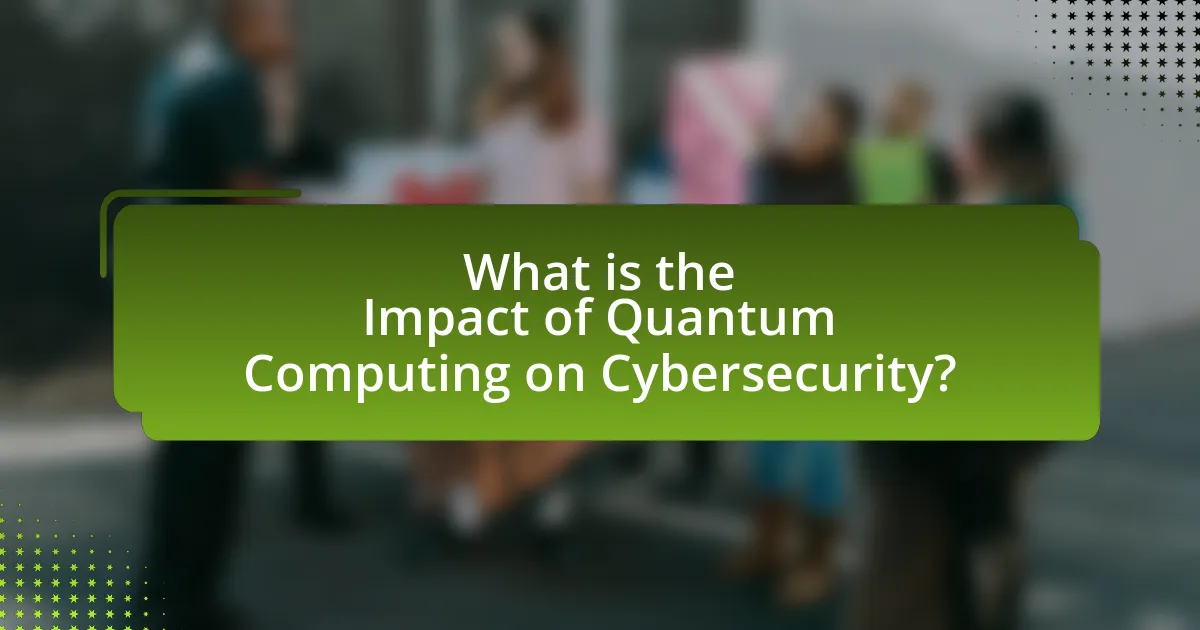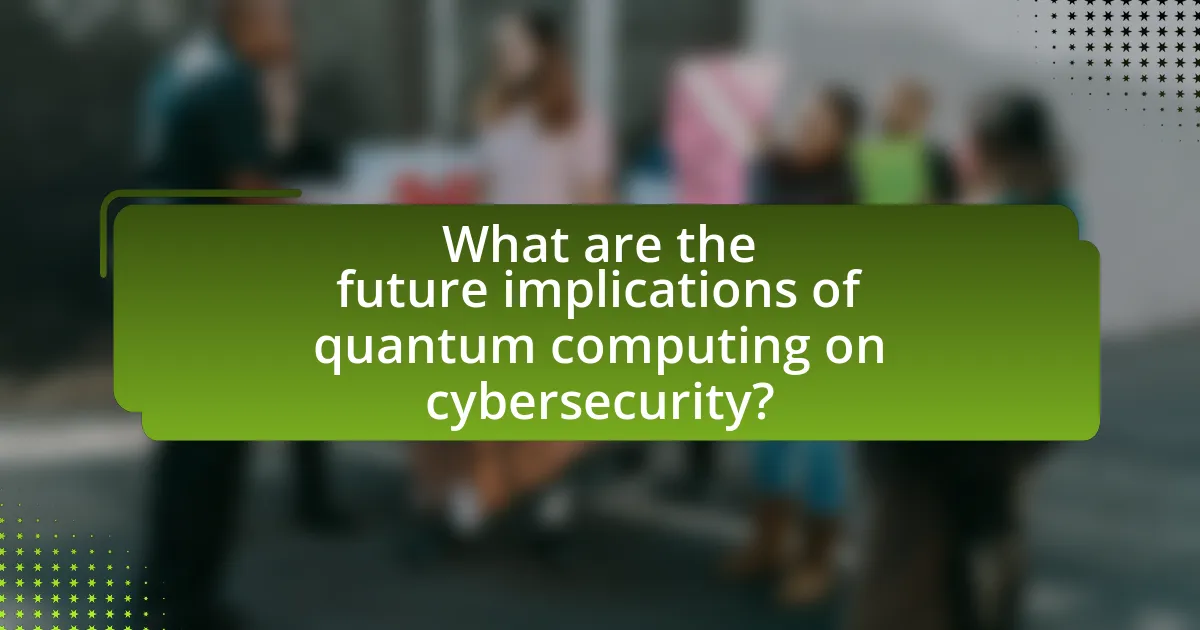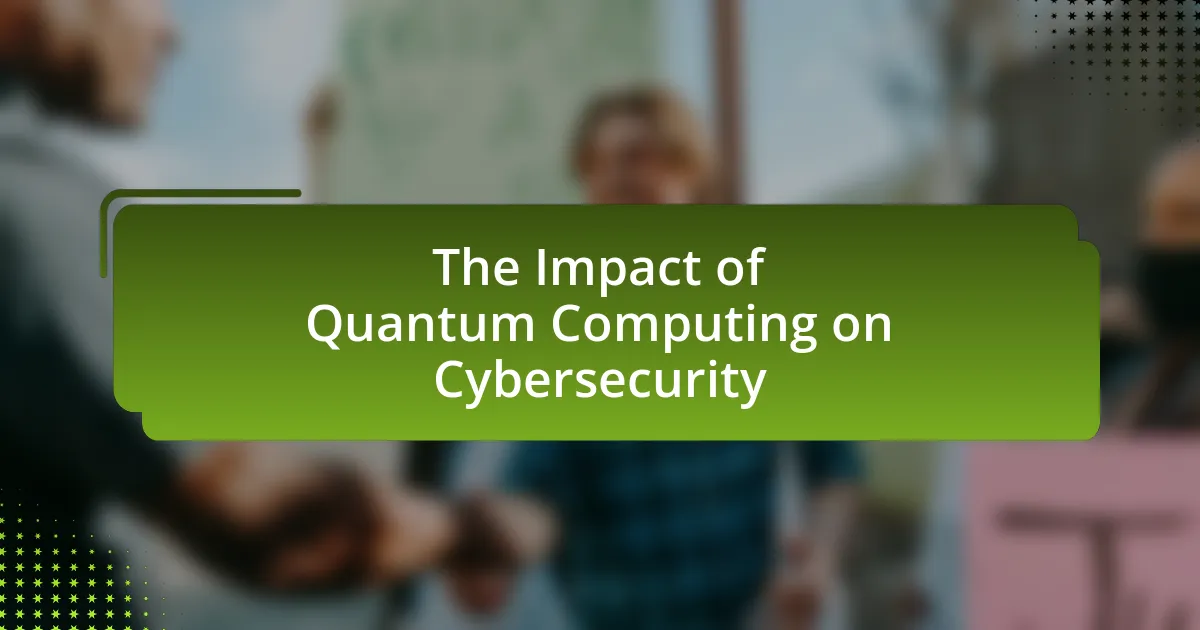Quantum computing represents a transformative force in the field of cybersecurity, posing significant threats to traditional encryption methods such as RSA and ECC. This article examines how quantum computers, through algorithms like Shor’s and Grover’s, can efficiently break existing encryption schemes, thereby compromising data confidentiality and integrity. It also explores the fundamental principles of quantum computing relevant to cybersecurity, the challenges it presents to current practices, and the urgent need for quantum-resistant cryptographic techniques. Additionally, the article highlights ongoing research efforts, industry preparations, and strategies organizations can adopt to mitigate quantum-related risks and enhance their cybersecurity frameworks.

What is the Impact of Quantum Computing on Cybersecurity?
Quantum computing poses a significant threat to cybersecurity by potentially breaking widely used encryption methods. Traditional encryption algorithms, such as RSA and ECC, rely on the difficulty of factoring large numbers and solving discrete logarithm problems, respectively. Quantum computers, utilizing algorithms like Shor’s algorithm, can solve these problems exponentially faster than classical computers, rendering current encryption methods vulnerable. Research indicates that a sufficiently powerful quantum computer could decrypt sensitive data in seconds, which underscores the urgency for developing quantum-resistant cryptographic techniques.
How does quantum computing differ from classical computing in cybersecurity?
Quantum computing fundamentally differs from classical computing in cybersecurity by its ability to solve complex problems exponentially faster, which poses significant risks to traditional encryption methods. Classical computing relies on algorithms that take a considerable amount of time to break encryption keys, such as RSA, which can take years or even centuries. In contrast, quantum computers utilize quantum bits (qubits) and algorithms like Shor’s algorithm, which can factor large numbers in polynomial time, potentially breaking RSA encryption in a matter of seconds. This capability threatens the security of data transmission and storage, necessitating the development of quantum-resistant cryptographic algorithms to safeguard sensitive information against future quantum attacks.
What are the fundamental principles of quantum computing relevant to cybersecurity?
The fundamental principles of quantum computing relevant to cybersecurity include superposition, entanglement, and quantum algorithms. Superposition allows quantum bits (qubits) to exist in multiple states simultaneously, enabling complex computations that classical computers cannot perform efficiently. Entanglement creates a correlation between qubits, such that the state of one qubit can depend on the state of another, regardless of distance, which can enhance secure communication protocols. Quantum algorithms, such as Shor’s algorithm, can factor large numbers exponentially faster than classical algorithms, posing a threat to traditional encryption methods like RSA. This capability necessitates the development of quantum-resistant cryptographic techniques to safeguard sensitive information against potential quantum attacks.
How does quantum computing challenge traditional cybersecurity measures?
Quantum computing challenges traditional cybersecurity measures primarily by its ability to efficiently solve problems that are currently intractable for classical computers, particularly in the realm of cryptography. For instance, quantum algorithms like Shor’s algorithm can factor large integers exponentially faster than the best-known classical algorithms, which undermines the security of widely used encryption methods such as RSA and ECC. This capability poses a significant threat to data confidentiality and integrity, as sensitive information protected by these encryption standards could be decrypted in a feasible time frame using quantum computers.
What potential threats does quantum computing pose to current cybersecurity practices?
Quantum computing poses significant threats to current cybersecurity practices by potentially breaking widely used encryption algorithms. For instance, Shor’s algorithm enables quantum computers to factor large integers efficiently, which undermines the security of RSA encryption, a standard for securing sensitive data. This capability could allow malicious actors to decrypt confidential communications and access sensitive information, fundamentally compromising data integrity and confidentiality. Additionally, Grover’s algorithm could reduce the effective key length of symmetric encryption, making it easier for attackers to perform brute-force attacks. The implications of these threats necessitate a reevaluation of existing cybersecurity frameworks to incorporate quantum-resistant algorithms.
How can quantum computers break existing encryption methods?
Quantum computers can break existing encryption methods primarily through their ability to efficiently solve mathematical problems that underpin these encryption schemes. For instance, Shor’s algorithm enables quantum computers to factor large integers exponentially faster than classical computers, which directly threatens RSA encryption, widely used for secure data transmission. Additionally, quantum computers can use Grover’s algorithm to perform brute-force searches on symmetric key algorithms, effectively halving the key length’s security. This capability poses a significant risk to encryption methods that rely on the difficulty of these mathematical problems, as demonstrated by theoretical analyses and simulations showing that quantum algorithms can outperform classical counterparts in these tasks.
What are the implications of quantum computing for data privacy and security?
Quantum computing poses significant implications for data privacy and security by potentially breaking traditional encryption methods. Classical encryption algorithms, such as RSA and ECC, rely on the difficulty of factoring large numbers or solving discrete logarithm problems, which quantum computers can solve efficiently using algorithms like Shor’s algorithm. This capability threatens the confidentiality of sensitive data, as quantum computers could decrypt information that is currently considered secure.
Research indicates that as quantum technology advances, the risk of data breaches increases, necessitating the development of quantum-resistant cryptographic algorithms. The National Institute of Standards and Technology (NIST) is actively working on standardizing post-quantum cryptography to mitigate these risks. Therefore, the transition to quantum-resistant encryption is crucial for maintaining data privacy and security in a future where quantum computing is prevalent.
What opportunities does quantum computing present for enhancing cybersecurity?
Quantum computing presents significant opportunities for enhancing cybersecurity by enabling the development of advanced cryptographic algorithms that are resistant to attacks from classical computers. Quantum key distribution (QKD) is one such method, utilizing the principles of quantum mechanics to securely share encryption keys, ensuring that any eavesdropping attempts can be detected. Research has shown that QKD can provide unconditional security, as demonstrated in experiments conducted by the University of Science and Technology of China, where secure communication was achieved over long distances using quantum entanglement. Additionally, quantum computing can facilitate the creation of post-quantum cryptography, which aims to develop encryption methods that remain secure against potential future quantum attacks, thereby strengthening overall cybersecurity frameworks.
How can quantum key distribution improve secure communications?
Quantum key distribution (QKD) improves secure communications by enabling the generation and sharing of cryptographic keys with a level of security that is theoretically unbreakable. QKD utilizes the principles of quantum mechanics, specifically the behavior of photons, to ensure that any attempt to eavesdrop on the key exchange will disturb the quantum states being transmitted, alerting the communicating parties to the presence of an intruder. This capability is supported by the no-cloning theorem, which states that it is impossible to create an identical copy of an unknown quantum state, thus ensuring that the key remains secure. As a result, QKD provides a robust framework for secure communication, making it resistant to conventional hacking methods and future threats posed by quantum computers.
What role does quantum computing play in developing new cryptographic algorithms?
Quantum computing significantly influences the development of new cryptographic algorithms by enabling the creation of encryption methods that can withstand quantum attacks. Traditional cryptographic algorithms, such as RSA and ECC, are vulnerable to quantum algorithms like Shor’s algorithm, which can efficiently factor large numbers and solve discrete logarithm problems. As a result, researchers are focusing on post-quantum cryptography, which aims to develop algorithms based on mathematical problems that remain secure even in the presence of quantum computing capabilities. For instance, lattice-based cryptography and hash-based signatures are being explored as potential solutions to ensure data security in a quantum future.

How is the cybersecurity industry preparing for the quantum computing era?
The cybersecurity industry is preparing for the quantum computing era by developing quantum-resistant cryptographic algorithms. Organizations such as the National Institute of Standards and Technology (NIST) are actively working on standardizing post-quantum cryptography to ensure that encryption methods remain secure against the potential threats posed by quantum computers. In 2022, NIST announced the first group of algorithms selected for standardization, which includes lattice-based, hash-based, and code-based cryptographic systems, all designed to withstand quantum attacks. This proactive approach aims to safeguard sensitive data and maintain the integrity of cybersecurity frameworks as quantum technology advances.
What strategies are organizations adopting to mitigate quantum threats?
Organizations are adopting several strategies to mitigate quantum threats, primarily focusing on transitioning to quantum-resistant cryptographic algorithms. This shift is essential as quantum computers can potentially break widely used encryption methods, such as RSA and ECC, which protect sensitive data. For instance, the National Institute of Standards and Technology (NIST) is actively working on standardizing post-quantum cryptography, with the aim of providing secure algorithms that can withstand quantum attacks. Additionally, organizations are conducting risk assessments to identify vulnerabilities in their current systems and implementing hybrid cryptographic solutions that combine classical and quantum-resistant algorithms to enhance security during the transition period. These proactive measures are crucial for safeguarding data integrity and confidentiality in the face of advancing quantum computing capabilities.
How are businesses transitioning to quantum-resistant encryption methods?
Businesses are transitioning to quantum-resistant encryption methods by adopting algorithms that are designed to withstand the potential threats posed by quantum computing. This shift involves implementing post-quantum cryptographic algorithms, such as lattice-based, hash-based, and code-based cryptography, which have been identified as secure against quantum attacks. For instance, the National Institute of Standards and Technology (NIST) has been actively working on standardizing post-quantum cryptographic algorithms, with the first round of selected candidates announced in July 2022. Companies are also conducting risk assessments to identify vulnerabilities in their current encryption systems and are investing in training their IT staff to understand and implement these new technologies effectively.
What partnerships are forming between tech companies and cybersecurity firms?
Tech companies are increasingly forming partnerships with cybersecurity firms to enhance their security measures against emerging threats, particularly those posed by quantum computing. For instance, IBM has collaborated with various cybersecurity firms to develop quantum-safe encryption methods, aiming to protect sensitive data from potential quantum attacks. Additionally, Microsoft has partnered with cybersecurity companies to integrate advanced threat detection systems that leverage quantum computing capabilities, ensuring robust defenses against sophisticated cyber threats. These collaborations are essential as they combine technological advancements with specialized security expertise, addressing the vulnerabilities that quantum computing introduces to traditional cybersecurity frameworks.
What research and development efforts are underway in quantum cybersecurity?
Research and development efforts in quantum cybersecurity focus on creating quantum-resistant cryptographic algorithms and secure communication protocols. Organizations like the National Institute of Standards and Technology (NIST) are actively working on standardizing post-quantum cryptography, with the aim of selecting algorithms that can withstand quantum attacks. In 2022, NIST announced the first group of algorithms for standardization, including CRYSTALS-KYBER and CRYSTALS-DILITHIUM, which are designed to secure data against potential threats posed by quantum computers. Additionally, various universities and research institutions are exploring quantum key distribution (QKD) technologies, which leverage the principles of quantum mechanics to enable secure communication channels that are theoretically immune to eavesdropping. These efforts are critical as quantum computing advances, posing risks to traditional encryption methods.
Which institutions are leading the way in quantum cybersecurity research?
The institutions leading the way in quantum cybersecurity research include the Massachusetts Institute of Technology (MIT), Stanford University, and the University of California, Berkeley. MIT’s Research Laboratory of Electronics focuses on quantum information science, while Stanford’s Quantum Computing and Quantum Information group conducts significant research in quantum cryptography. The University of California, Berkeley, is known for its work in quantum algorithms and secure communication protocols. These institutions are recognized for their contributions to advancing the field, evidenced by numerous publications and collaborations in quantum cybersecurity initiatives.
What are the latest advancements in quantum-safe cryptography?
Recent advancements in quantum-safe cryptography include the development of new algorithms such as lattice-based, code-based, and multivariate polynomial cryptography, which are designed to resist attacks from quantum computers. For instance, the National Institute of Standards and Technology (NIST) has been actively working on standardizing post-quantum cryptographic algorithms, with the finalization of four algorithms in July 2022, including CRYSTALS-Kyber for key encapsulation and CRYSTALS-DILITHIUM for digital signatures. These algorithms have undergone rigorous testing and evaluation to ensure their security against potential quantum threats, marking a significant step towards securing data in a post-quantum world.

What are the future implications of quantum computing on cybersecurity?
Quantum computing will significantly disrupt cybersecurity by rendering current encryption methods obsolete. As quantum computers become more powerful, they will be capable of breaking widely used cryptographic algorithms, such as RSA and ECC, which rely on the difficulty of factoring large numbers and solving discrete logarithm problems. For instance, a sufficiently advanced quantum computer could theoretically factor a 2048-bit RSA key in a matter of seconds, a task that would take classical computers millions of years. This potential threat necessitates the development of quantum-resistant algorithms to secure sensitive data against future quantum attacks.
How will the landscape of cybersecurity evolve with quantum computing?
Quantum computing will significantly transform the landscape of cybersecurity by rendering traditional encryption methods vulnerable. Current cryptographic algorithms, such as RSA and ECC, rely on the difficulty of factoring large numbers and solving discrete logarithms, respectively. Quantum computers, utilizing algorithms like Shor’s algorithm, can efficiently break these encryption schemes, posing a threat to data security. Research indicates that a sufficiently powerful quantum computer could decrypt sensitive information in seconds, which underscores the urgency for developing quantum-resistant cryptographic methods. The National Institute of Standards and Technology (NIST) is actively working on post-quantum cryptography standards to address these vulnerabilities, highlighting the proactive measures being taken to secure data against future quantum threats.
What new cybersecurity threats might emerge as quantum technology advances?
As quantum technology advances, new cybersecurity threats will likely include the ability of quantum computers to break traditional encryption methods, such as RSA and ECC, which currently secure sensitive data. Quantum computers can leverage algorithms like Shor’s algorithm to factor large integers exponentially faster than classical computers, rendering existing cryptographic systems vulnerable. Research indicates that once sufficiently powerful quantum computers are available, they could compromise encrypted communications and data storage, posing significant risks to national security, financial systems, and personal privacy. The National Institute of Standards and Technology (NIST) has been actively working on post-quantum cryptography standards to mitigate these threats, highlighting the urgency of addressing the vulnerabilities introduced by quantum advancements.
How can organizations stay ahead of quantum-related cybersecurity challenges?
Organizations can stay ahead of quantum-related cybersecurity challenges by adopting quantum-resistant cryptographic algorithms. These algorithms are designed to withstand the potential threats posed by quantum computers, which can break traditional encryption methods. For instance, the National Institute of Standards and Technology (NIST) is currently in the process of standardizing post-quantum cryptography, which provides a framework for organizations to transition to more secure encryption methods. By proactively implementing these standards and continuously updating their security protocols, organizations can mitigate risks associated with quantum computing advancements.
What best practices should organizations implement to prepare for quantum computing?
Organizations should implement a multi-faceted approach to prepare for quantum computing, focusing on developing quantum-resistant cryptographic algorithms. This preparation is essential because quantum computers can potentially break widely used encryption methods, such as RSA and ECC, which protect sensitive data.
To effectively prepare, organizations should conduct a thorough risk assessment to identify vulnerabilities in their current cryptographic systems. They should also invest in research and development of quantum-safe algorithms, as recommended by the National Institute of Standards and Technology (NIST), which is actively working on standardizing post-quantum cryptography.
Additionally, organizations should engage in continuous education and training for their IT staff on quantum computing advancements and implications for cybersecurity. Collaborating with industry partners and participating in quantum computing forums can also enhance knowledge sharing and preparedness.
By adopting these best practices, organizations can mitigate risks associated with the advent of quantum computing and ensure the security of their data in a post-quantum world.
How can businesses assess their current cybersecurity posture against quantum threats?
Businesses can assess their current cybersecurity posture against quantum threats by conducting a comprehensive risk assessment that evaluates their existing encryption methods and identifies vulnerabilities to quantum computing capabilities. This assessment should include an analysis of current cryptographic algorithms, as many traditional encryption methods, such as RSA and ECC, are susceptible to quantum attacks, specifically Shor’s algorithm, which can efficiently factor large integers and compute discrete logarithms.
To validate this approach, organizations can reference the National Institute of Standards and Technology (NIST) ongoing efforts to standardize post-quantum cryptographic algorithms, which aim to provide secure alternatives against quantum threats. By aligning their cybersecurity strategies with NIST’s recommendations and conducting regular penetration testing and vulnerability assessments, businesses can effectively gauge their readiness against potential quantum computing risks.
What training and resources are essential for cybersecurity professionals in the quantum era?
Cybersecurity professionals in the quantum era require specialized training in quantum cryptography, quantum algorithms, and post-quantum cryptography. This training is essential because quantum computing poses significant threats to traditional encryption methods, necessitating a shift in cybersecurity strategies. Resources such as online courses from institutions like MIT and Stanford, research papers on quantum-safe algorithms, and participation in workshops focused on quantum technologies are critical for staying updated. For instance, the National Institute of Standards and Technology (NIST) is actively developing post-quantum cryptographic standards, providing a framework for professionals to follow.



